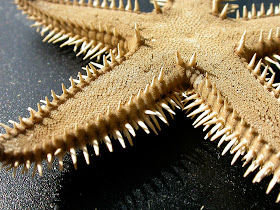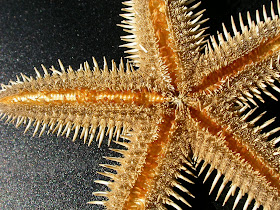 So today, I thought I would finally indulge those of you who are in constant puzzlement over how to tell the difference between two of the more common "sand stars" found throughout the Indo-Pacific!
So today, I thought I would finally indulge those of you who are in constant puzzlement over how to tell the difference between two of the more common "sand stars" found throughout the Indo-Pacific!This is a surprisingly common question and its not just my colleagues who repeatedly ask me this -I frequently see these two species mistaken for one another in tropical aquarium and "shell collector" magazines, websites and so on..
Hopefully, the names of these two species can be consistently applied. And that's generally good for everyone in the long run...
Know Your Sand Stars! Convergence between Astropecten and Archaster?
So, first, we are talking about TWO different species from two different families in two entirely separate orders.
Astropecten in the Astropectinidae, Order Paxillosida (I will refer to the species Astropecten polyacanthus for simplicity's sake).
Astropecten is distributed worldwide and occurs primarily in the shallow-water tropics-but also to a certain extent in temperate to cold water (occasionally in deeper depths)
Here is a nice video example of Astropecten (prob. A. polyacanthus) very efficiently burying/unburying itself...
I should add the caveat that there's just over 100 species of Astropecten throughout the world and a fair number of them are present in the tropical Indo-Pacific.. So, there may be SOME variation if you are looking at different species of Astropecten wherever you may be reading this..
Archaster in the Archasteridae, Order Valvatida. Found in shallow water throughout the tropical Indo-Pacific . Archaster also makes a point of burying itself into sediment... (yeah-there's no single video that is as good as the one above..so these will have to do!)
In spite of belonging to two completely different and distant groups of starfish, BOTH live in sandy bottoms with loose, unconsolidated sediment and possess the ability to dig and hide under that sand or sediment.
As a consequence these taxa display a number of superficial similarities that are adaptations for each respective species to live buried in a sandy, muddy or otherwise unconsolidated bottom environment.
In vertebrates, you would see this same kind of relationship-called convergent evolution between dolphins (which are mammals) and fish (which are not). Several consistent morphological features, which appear similar, but that arise in very separate evolutionary groups as adaptations to a particular way of life.
In the case between dolphins and fish-the fins and smooth lemon drop shape are adaptations to life swimming through the water.
In the case of these starfish-the location of the spines and the certain similarities in body shape are independent adaptations to digging through sediment.
Hence..the word "sand star" could apply to both. (And that's why I dislike common names...)
These two species are frequently mistaken for one another. and Archaster is apparently quite common and abundant.. So usually, people mistake Astropecten for Archaster

So, How Do We Tell Them Apart?
1. The Radial Plate series (aka the carinal plates)
So-if there's one immediate and obvious character to use-its the distinctive central row of plates on each arm.
 Indicated below in blue
Indicated below in blue This is versus Astropecten which basically has NO distinctive radial line or series of plates... Its just a big jumble...
This is versus Astropecten which basically has NO distinctive radial line or series of plates... Its just a big jumble...
 2. Suckered vs. Pointed Tube Feet
2. Suckered vs. Pointed Tube FeetAnother immediately obvious difference between the two..
Archaster has actual suckered tube feet.... As seen here on this video..
This is as opposed to Astropecten which have pointed or knobby ends on their tube feet..
 3. Body Shape and Spines on the Outline of the Body.
3. Body Shape and Spines on the Outline of the Body.Archaster only has big flat spines on the lower side of its body that flank the oral surface.. If there are spines on the upper surface, they are small and tiny..
 Plus..the body itself is shaped rather distinctively. with the rather long-tapering arms
Plus..the body itself is shaped rather distinctively. with the rather long-tapering arms There is more of a prominent angle formed between the surface and the side of the body. Also, the top surface is more flattened...
There is more of a prominent angle formed between the surface and the side of the body. Also, the top surface is more flattened... In contast, Astropecten can have broader more triangular arms. This can vary by species-but if you find an Astropecten in the tropical shallow waters of the Indo-Pacific, it will look very similar to this...
In contast, Astropecten can have broader more triangular arms. This can vary by species-but if you find an Astropecten in the tropical shallow waters of the Indo-Pacific, it will look very similar to this... Arm is more triangular. And many species of Astropecten will have a very prominent perimeter of spines around the body's edge.
Arm is more triangular. And many species of Astropecten will have a very prominent perimeter of spines around the body's edge.There is more of a curved angle formed by the top and the lateral side. And you'll often find the top surface to be more swollen and curved. Not as flat as you would find in Archaster...
 4. The Spines are Different.
4. The Spines are Different.Note that these spines are round and sharp rather than flat and blunt.
 You can especially see the difference in the abundance and the type of spines on the bottom (oral) surface...
You can especially see the difference in the abundance and the type of spines on the bottom (oral) surface... In Archaster, the spines are flattened and blunt!!
In Archaster, the spines are flattened and blunt!! To the seasoned expert, there are actually MORE differences than this. But these were the characteristics that I thought were the easiest to tell apart for those who are simply observing the exterior.
To the seasoned expert, there are actually MORE differences than this. But these were the characteristics that I thought were the easiest to tell apart for those who are simply observing the exterior.It turns out Archaster is probably one of the more heavily fished starfish species. Not only for aquariums, but one also sees this species on sale for arts & crafts and shell-collector websites and ebay.. but Astropecten turns up as well.. This pic gives you an idea of where this species ends up...
What might the impact be of overfishing these species? The first step is knowing which one is which...






























